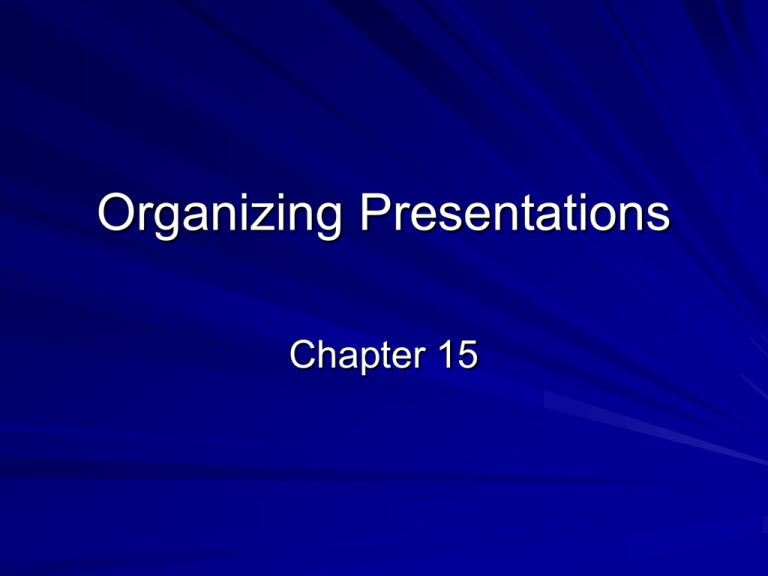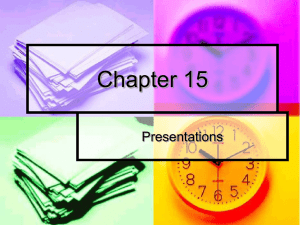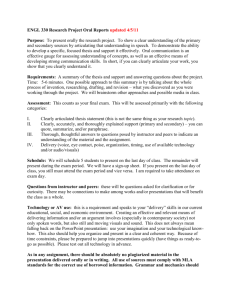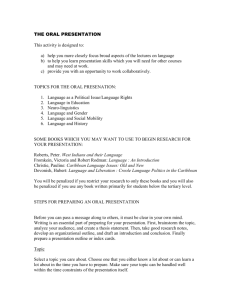C 15 - WordPress.com
advertisement

Organizing Presentations Chapter 15 Parts of a Presentation Section 1 Objectives 1. Identify the five purposes of an introduction. 2. Apply effective methods for getting an audience's attention. 3. Develop clear thesis statements. 4. Explain three reasons for audience orientation. 5. Identify and explain the three purposes of a conclusion. Presentations Most presentations consist of three main elements. – 1. Introduction – 2. Body – 3. Conclusion Introduction Get the audience’s attention – An opportunity to grab your audience’s attention before getting to the important information of your topic – Attention device Humor Quotations Stories References to the occasion, audience, or topic Rhetorical questions Startling statements Personal experiences Choose appropriately for the presentation. Introduction State your thesis – A thesis statement is a clearly written, simple sentence or question that states the point you expect to make in your presentation. If you only had the time to say one sentence to your audience, what would it be? Establish your Ethos as a Speaker – You might want to provide information about yourself, your specific expertise, or the research you have done on the topic so that the audience knows that you are qualified to speak on that topic. Introduction Orient the Audience-Provide the audience with an audience orientation. This provides audience members with information they likely do not already have but will need. To determine whether an orientation is needed, consider these audience needs: -Audience Orientations Definition Background information Motivation Introduction Preview Your Main Points- This is a courtesy that you provide for your audience to let them know what to listen for during the presentation. This can be done in one simple sentence or broken up into several sentences Put It All Together- At the end of your introduction, the audience should have no doubt about what it will gain by listening to your presentation. The Body In a presentation, you will rarely be able to share everything you know about a topic. To determine what information to include, focus on exactly what the audience needs to know to meet both your objective and theirs. The body is made up of only two to five main points. Less is better! Time is a very important factor, 75 to 85 percent of the presentation is the body. This is the part of the presentation that requires the most preparation time and effort. The Body Determine the Main Points– The first step in determining the main points of a presentation is to consider the purpose of the presentation. – The second step is to refer to your thesis statement. Each main point must support the thesis. – The final factor is the availability of information. You need information to support your idea The Body Make Smooth Transitions – Transitions not only join the main points together, but also link the introduction and conclusion to the main body. Using transitions can help you – -put ideas together -illustrate a point -compare or contrast points -emphasize a point -arrange points in order -repeat or provide a summary of the important points -relate points through location or time The Conclusion A conclusion is the ending that pulls the presentation together. It serves three purposes– Summarize the Main Points – a simple restatement of you main points or a strong appeal that reinforces the central theme – Restate the Thesis – this final statement of your topic or purpose serves as a vehicle to pull the entire presentation together. – Provide a Clear Ending – your final chance to make a lasting impression. Patterns of Organization Section 2 Objectives 1. Select appropriate strategies to organize a presentation. 2. Explain Monroe’s Motivated Sequence. 3. Use effective strategies to outline a presentation. Patterns of Organization for Informative Presentations Chronological Order – an arrangement according to the time in which something occurs. – Daily routine, timed activities, class schedule Sequential Order – an arrangement according to the steps in a process, information is arranged according to a particular succession. – Directions to a friend’s house, when giving instructions for a task. Patterns of Organization for Informative Presentations Spatial Order – an arrangement according to how a topic is put together or by the physical location of its elements. – Describing your school building, the weather forecast Topical Order – groups ideas by some logical theme or division. Points are usually arranged by order of importance – Describing the various sports, clubs, and activities at your school Patterns of Organization for Persuasive And Motivational Presentations Cause-Effect Organization – the first part, cause, brings about some action, event, or situation. The second part, effect, is the consequence of that action, event, or situation. Problem-Solution Organization – first there is a problem, then the second step is the solution to that problem. – Advantages-disadvantages of solutions are usually discussed at this point. Monroe’s Motivated Sequence A five part organizational strategy designed for speeches that seek to persuade or motivate an audience to take immediate action. It is based on two assumptions – that everyone has needs and people can be persuaded by claims that satisfy those needs. Monroe’s Motivated Sequence Attention – to create audience interest in learning or knowing more by getting their attention. Need – you make your audience aware that a problem or need exists and that they are related to it directly. Satisfaction – you present your solution for the problem you just explained. Visualization – help your audience visualize the benefits of your solution. Action – tell the audience exactly what you want them to do and how to go about doing it. Preparing Your Presentation Outline An outline for a presentation follows the structure of your presentation. Example – I. Introduction A. Introductory Device B. Thesis Statement C. Establish Speaker Ethos D. Audience Orientation 1. Definitions 2. Background 3. Motivation E. Preview Main Parts Preparing Your Presentation Outline II. Body A. Main Point 1 1. Supporting Information B. Main Point 2 1. Supporting Information C. Main Point 3 1. Supporting Information III. Conclusion A. Summary B. Second Thesis Statement C. Concluding Device





